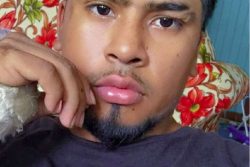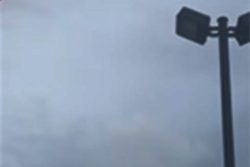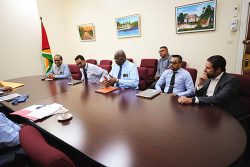The south of Guyana is particularly vulnerable to the spread of the coronavirus, not just because of the regular traffic from Georgetown, but also because it is wide open to traffic from Brazil. And in terms of infections, Brazil as of Friday had the highest number worldwide after the US and Russia, at 310,000. Medical experts have said, however, that the real figure is probably far higher than this because of insufficient testing. Covid-19 in the neighbouring state began in the cities, but is now spreading to forested and other isolated areas. At the end of last week, Reuters reported the Mayor of Manaus as expressing the fear that it would cause genocide among the indigenous peoples who were more vulnerable to the disease than other sectors of the population.
The official border crossing with Brazil at the Takutu Bridge is currently closed, but that is little impediment to those who would come here, since there are a number of places where the river can be negotiated out of sight of the authorities. It is because of this that the Rupununi acquired its first coronavirus case the Monday before last, when Hamlett DaSilva used one of these unofficial crossing points to come here. He was Brazilian based, and visited various Indigenous communities from Toruka in Region Eight to Aishalton in the far south. He was placed in an isolation facility in Lethem, but escaped from there, to be recaptured not long after in Brazil, where he is currently being monitored.
In the course of cutting a swathe through Guyana’s Indigenous villages, Mr DaSilva managed to come into contact with a comparatively large number of residents. As a consequence 130 of them had subsequently to be placed in quarantine.
This instance of contact tracing involved a wide geographical area and a large number of contacts in circumstances where there was only one infected agent. But that is the problem with many parts of Guyana’s interior and with the Rupununi in particular: distances are vast, villages widely scattered, and those from outside seeking to do business tend to visit any number of communities. If the authorities had been faced with the prospect of tracing the contacts of several Brazilians who had come here at the same time and were later discovered to be infected, they would have found it difficult to find everyone, and the possibility of community transmission would have loomed large.
Ideally the security forces should be monitoring the Takutu river to prevent any illegal crossings. However, given the geography of the area and various other constraints, that is far easier said than done. One might think that they should be investing in drones to help police difficult border zones, although whether that possibility is being explored is not known. Be that as it may, the South Rupununi villages themselves have instituted lockdown arrangements which in theory should protect them from Brazilian-based and other visitors, but they have so far not been allowed to implement them fully.
The major danger to the health of Indigenous people in the region at the moment is coming from a different, but related direction. There are mining operations at Marudi and Wakadanao in the far south, and in order to access these miners have to pass through a number of communities. Since the villages have recently introduced checkpoints and gates at the entrance to their settlements in order to restrict traffic, they have inevitably come into conflict with the Rupununi Miners Association. It had not escaped the attention of the Toshaos and their councils that Mr DaSilva was as miner, and they would know that many of the miners who pass through their communities would have contact with Brazilians for their equipment, among other things. At the very least, they would be travelling to Georgetown on a regular basis, and would have contacts with urban-based residents.
The problem is that mining and mining-related activities are classified by the Covid-19 Task Force as ‘Essential Services’, and as Region Nine Regional Executive Officer (REO) Mr Carl Parker explained to this newspaper, since the roads through the villages are government thoroughfares, under the Amerindian Act of 2006 the villagers may “not obstruct the lawful passage of any person through village lands.” Given that, he said the Indigenous representatives had indicated they thought that miners passing through should not be allowed to stop. “But then how do we control that?” he asked rhetorically, “given the fact that these villages are sprawling and there are shops along the way in the villages and miners will, invariably while passing through those villages, stop at shops to buy a few beers and food supplies…”
The REO told Stabroek News that he had arranged a meeting between the executive of the Rupununi Miners Association and the National Toshaos Council, along with several Toshaos from the South Rupununi in a bid to look for “amicable solutions.” He said the Toshaos will be told they cannot block main roads, while the Rupununi Miners will be informed they will have to take responsibility for the actions of their members. He did say that the region would support the communities in establishing checkpoints and would be distributing thermometers provided they agreed to keep their gates open between 6 am and 6 pm.
Unfortunately there is no such thing as an “amicable solution” in this situation. The issue is the health of the population versus the vested economic interest of a group of miners, who, it might be noted, would also suffer if the virus took hold in the region.
As far as the specifics of any such potential agreement are concerned, the Rupununi Miners Association is in no position to control the behaviour of its members in the communities, while miners in general – although certainly not all of them – have in any case no great record as respecters of Indigenous people. The South Rupununi District Council which represents 21 communities adverted to the fact that wrong information is regularly given to those stationed at checkpoints in order to gain access to the villages. “We are very concerned that persons coming in can bring undetected cases of the Coronavirus into the mining areas which can then spread into our villages,” said the Council.
That the authorities in the capital are more anxious to protect the finances of the miners than they are to keep the Indigenous and other inhabitants safe became clear when Mr Parker disclosed that the Regional Health Emergency Committee had recommended a total lockdown “based on the fact that the Rupununi is very vulnerable on two sides—the Brazil threat and then we have persons coming in from Georgetown … We said if we had lock[ed] down the Rupununi, it would have been easier for contact tracing and it would have been easier to stop persons who would have come into contact with other people. Unfortunately, the national task force did not see with us and as such it was not approved.”
One wonders if the national Task Force had any grasp at all of the issues involved and the importance of cutting Lethem, in particular, off from contact with both Brazil and the capital. It is a decision that they urgently need to review. That said, the protection of the Indigenous population in the villages depends in the first instance in removing mining from the list of Essential Services and allowing the communities to implement their own lockdown measures. This has been urgently requested by the South Rupununi District Council and has also been recommended by the Guyana Human Rights Association. Apart from anything else, the region simply could not cope with any widespread outbreak of Covid-19, and the consequences for the residents of far-flung villages would be devastating. In addition, as the last-named organisation has pointed out, if the virus takes hold in the Rupununi, it will spread to the rest of the country.








